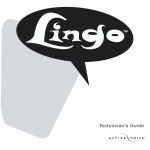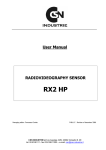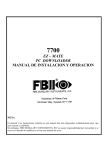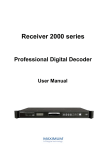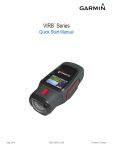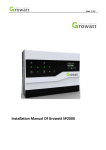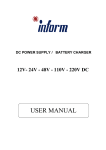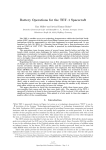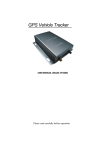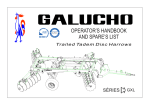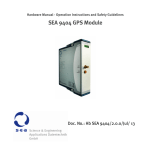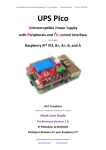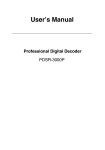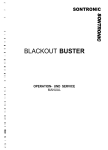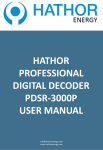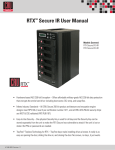Download EPC SLT Serisi Kesintisiz Güç Kaynağı Kullanım
Transcript
User Manual for INVERTER 1500-5000VA Ver1.0 Rev0 ENGLISH Inform Inverter Systems PAGE : 1 IMPORTANT This users manual contains setup, operation and maintenance information for Inverta Series DC/AC Static Inverter. Before starting setup and operation of the equipment, complete users manual should be read carefully. Before operation, the inverter should be prepared by an authorized technical person approved. The warranty will be void, if this direction is not followed. Please contact customer service, if you see any problem about any process described in this users manual. The manufacturer reserves the right to change the design of the equipment without notice. ELECTROMAGNETIC COMPABILITY This equipment if compatable to EMC directive 89/336/EEC and to conditions in released technical specifications. The compability remains only if related directions are followed and only if the equipment is used with accessories approved by the manufacturer. WARNING This is an A class inverter product. In closed environments, it can cause radio interference. In this case, extra precautions may be needed. WARNING ENGLISH This equipment contains RFI filter. Ground current should’nt be higher than 3.5mA. Ver1.0 Rev0 PAGE : 2 CAUTION 1. Do not open the cover. There are no user servicable parts inside. 2. Even after the equipment is disconnected from batteries and input connections, a intervention to the interior of the equipment contains risk of electric shock. 3. Ventilation holes should be kept open and no objects should be inserted. 4. In the environment where the equipment will be operated, the temperature and humidity should be relevant. 5. Magnetic computer equipments like diskets and CDs should be kept away at least 30 cm from the inverter system. 6. The equipment can not be operated in an environment having flammable and explosive devices. CAUTION ENGLISH In this manual, all items including terms BYPASS, AC INPUT and SYNCHRONISATION are only valid for devices having BYPASS input. Ver1.0 Rev0 PAGE : 3 CONTENT 1. 2. 3. 4. 5. 5 1.1 SYSTEM 5 1.2 ADVANTAGES 6 1.3 GENERAL FEATURES 7 1.4 ELECTRICAL & PHYSICAL FEATURES (24Vdc input devices) 8 1.5 ELECTRICAL & PHYSICAL FEATURES (48Vdc input Devices) 8 1.6 ELECTRICAL & PHYSICAL FEATURES (110Vdc input devices) 9 SETUP 11 2.1 OPENING PACKAGE 11 2.2 CHOOSING PROPER PLACE 11 2.3 ELECTRICAL CONNECTION 11 OPERATION 14 3.1 INITIAL USE OF EQUIPMENT AND OPERATION 14 3.2 TURNING OF THE EQUIPMENT 14 SERVICE AND MAINTENANCE 15 4.1 PERIODICAL MAINTENANCE 15 4.2 FAILURES 15 4.3 BEFORE CALLING SERVICE 15 FRONT PANEL 16 5.1 STRUCTURE OF FRONT PANEL 16 5.2 MEASUREMENTS MENU 18 5.3 CONTROL AND SETTINGS MENUS 20 5.4 USING BUTTONS 22 OPTIONS 24 6.1 SMART PORT (RS232 Communications) 24 6.2 REMOTE MONITORING PANEL 25 6.3 SNMP COMMUNICATIONS 26 6.4 DRY CONTACTS (Dry Port) 26 ENGLISH 6. GENERAL INTRODUCTION Ver1.0 Rev0 PAGE : 4 1. GENERAL INTRODUCTION 1.1 SYSTEM Inverta Series DC/AC Inverter’s are equipments produced to supply computer and communication systems, called as critical load. Inverta Series DC/AC Inverters converts DC voltages like batteries to AC voltage with desired voltage and frequency and suuplying AC power. SLT Series Frequency Converter is a real ON LINE equipment with sinusodial output waveform, having static transfer (BYPASS) system and all required protections. Because the equipment is designed ONLINE, it feeds load continously with the stable voltage and frequency generated by itself. Therefore, there is no interruption when the utility voltage fails and recovers. In an overload condition, the FC transfers the load to bypass line, if a bypass supply exist, otherwise it disables output. When the overload condition disappears, load is again feeded with the energy generated by the FC. Static transfer system acts as the same and prevents an intteruption, when the FC is failed. Basic components of the system and their functions are as following : Inverter : Converts the DC voltage produced by the rectifier to stable and regulated voltage with desired voltage and frequency. Static transfer system : In normal conditions, it switches output voltage generated by the inverter to the output of the FC. In case when the inverter fails to generate voltage in desired amplitude and frequency, static transfer system switches bypass input supply to the ouput. DC input : The equipment produces AC voltage, by inverting the DC input feeded from this source. ENGLISH Inverter block diagram is shown below. Ver1.0 Rev0 PAGE : 5 BYPASS INPUT Bypass C.B. TRANSFER SYSTEM DC INPUT INVERTER Inverter output C.B. SYSTEM OUTPUT (1 phase) DC input C.B. Figure 1.1 INVERTER BLOCK DIAGRAM 1.2 ADVANTAGES • Real ON LINE topology with 1 phase sinusodial output waveform • Internal isolation transformer at output • Capability to drive nonlineer loads (computers and switch mode power supplies) • IGBT technology with high frequency switching • High reliability with microprocessor and smart drivers • 2x16 character LCD display, showing measurements, status and alarm messages • Led displays for easy observation of Inverter status • Audible alarm • Bypass input (option) • Smart communication (RS232) and SNMP / HTTP support • Access to Inverter informations over Internet (option) • Ability to report Inverter status changes and failures via e-mail (option) • RFI filter at input and output for telecom applications • Language selection from front panel (Turkish / English) • Calibration of measurements from front panel • Rack mount cabinet • Ability to see total operation duration Ver1.0 Rev0 ENGLISH Advantages and properties of Inverta Series DC/AC Static Inverter are as following. PAGE : 6 1.3 GENERAL FEATURES INDICATIONS AND ALARMS Digital Indicators (on LCD Display) Alarm Messages (on LCD Display) Led Indicators Load Percentage Output Voltage Battery Voltage Input Voltage Inverter Frequency Battery Percentage Maximum Load Percentage Synchronization Status Alarms Load on Bypass Overload Bypass Failure Output Low / High Over Temperature Battery Voltage Too Low / Low / High Short Circuit / IPM Fault Load on Bypass Load on INVERTER Alarm COMMNICATION & REMOTE MONITORING Management and Monitoring Dry Contact Outputs HTTP / SNMP Compability 0°C / + 40°C -20°C / + 50°C %0 - %90 (non condensing) 2000 meters maximum ENGLISH PHYSICAL PROPERTIES Operation Temperature Storage Temperature Relative Humidity Operation Altitude Dry Contact Informations RS232 Serial Port (Megatec Protocol) Remote Monitoring Panel SNMP (Simple Network Management Protocol) Load on INVERTER / Bypass Battery Low / Normal UNIX LINUX NOVELL Windows 98 Windows XP Ver1.0 Rev0 PAGE : 7 1.4 ELECTRICAL & PHYSICAL FEATURES (24Vdc input devices) 1500 VA BYPASS INPUT Voltage Frequency DC INPUT (BATTERY INPUT) Voltage Current (Maximum) OUTPUT Voltage Current (Nominal) Surge Current (for 5 seconds) Frequency (Syncronized to bypass) Frequency (Running from battery) Power Factor (cos ϕ) Permitted Active Power Crest Factor Output Voltage Shape Total Harmonic Distortion Overall Optimum Efficiency 2500 VA 110 Vac / 220 Vac ± %15 50 Hz / 60Hz / 83 Hz / 400Hz ± %15 20 Vdc – 40 Vdc 75 Adc 6.8 Aac / 13.6 Aac 9 Aac / 18 Aac 121 Adc 110 Vac / 220 Vac ± % 1 11.4 Aac / 22.8 Aac 12 Aac / 24 Aac 50 Hz / 60 Hz / 83 Hz / 400 Hz ± % 1 50 Hz / 60 Hz / 83 Hz / 400 Hz ± % 0.1 0.7 1050 W 2.5 : 1 1750 W 2:1 Sinus <%3 > % 78 > % 81 6 minutes at 101% load - 10 seconds at 125% load Linear between 101% - 125% Direct off / bypass over 125% load Overload Tolerance 1.5 ELECTRICAL & PHYSICAL FEATURES (48Vdc input Devices) 2000 VA Overload Tolerance Ver1.0 Rev0 3000 VA 5000 VA 110 Vac / 220 Vac ± %15 50 Hz / 60Hz / 83 Hz / 400Hz ± %15 48 Adc 40 Vdc – 80 Vdc 71 Adc 120 Adc 9.1 Aac / 18.2 Aac 16 Aac / 32 Aac 110 Vac / 220 Vac ± % 1 13.6 Aac / 27.2 Aac 24 Aac / 48 Aac 22.7 Aac / 45.4 Aac 25Aac / 50 Aac 50 Hz / 60 Hz / 83 Hz / 400 Hz ± % 1 50 Hz / 60 Hz / 83 Hz / 400 Hz ± % 0.1 0.7 2100 W 3500 W 2:1 2:1 Sinüs <%3 > % 78 > % 81 > % 85 6 minutes at 101% load - 10 seconds at 125% load Linear between 101% - 125% Direct off / bypass over 125% load 1400 W 3:1 PAGE : 8 ENGLISH BYPASS INPUT Voltage Frequency DC INPUT (BATTERY INPUT) Voltage Current (Maximum) OUTPUT Voltage Current (Nominal) Surge Current (for 5 seconds) Frequency (Syncronized to bypass) Frequency (Running from battery) Power Factor (cos ϕ) Permitted Active Power Crest Factor Output Voltage Shape Total Harmonic Distortion Overall Optimum Efficiency 1.6 ELECTRICAL & PHYSICAL FEATURES (110Vdc input devices) ENGLISH 4000 VA 5000 VA 7000 VA 10000 VA BYPASS INPUT Voltage 110 Vac / or 220 Vac ± %15 Frequency 50 Hz /or 60Hz / or 83 Hz ± %15 DC INPUT (BATTERY INPUT) Voltage 90 Vdc – 140 Vdc Current (Maximum) ÇIKIŞ Voltage 110 Vac / or 220 Vac ± % 1 36 Aac / 18.2 Aac 45.7 Aac / 22.2 Aac 63.2 Aac / 32.2 Aac 90 Aac / 45.4 Aac Current (Nominal) 99 Aac / 40 Aac 100 Aac / 50 Aac 138 Aac / 70 Aac 198 Aac / 100Aac Surge Current (for 5 seconds) Frequency (Syncronized to 50 Hz / or 60 Hz / or 83 Hz / or 400 Hz ± % 1 bypass) Frequency (Running from 50 Hz /or 60 Hz /or 83 Hz / or 400 Hz ± % 0.1 battery) 0.7 Power Factor (cos ϕ) Permitted Active Power 3200 W 3500 W 4900 W 7000W Crest Factor 3:1 3:1 3:1 3:1 Output Voltage Shape Sinüs Total Harmonic Distortion <%3 Overall Optimum Efficiency > % 85 > % 85 > % 87 > % 87 6 minutes at 101% load - 10 seconds at 125% load Overload Tolerance Linear between 101% - 125% Direct off / bypass over 125% load Ver1.0 Rev0 PAGE : 9 3 1 4 2 Front View 5 4 Görünüş Figure 1.3 FRONT AND REAR VIEW OF 1 PHASE INVERTER (RACK MOUNT) LCD display, keypad and led displays All monitoring and control of the inverter is performed via LCD display, keypad and led displays located here. 2 Input and output circuit breakers Input and output circuit breakers (DC & AC) are located here. 3 Carrying handles These are the carrying handles of the rack mount enclosure. 4 Heatsink hot air exhaust This is the hot air exhaust of the heatsink, where semiconductor components of the inverter are located. 5 Connection panel, cable inlets / outlets All power connections of inverter are made to terminals are located here. Cable inlet is from bottom. ENGLISH 1 Ver1.0 Rev0 PAGE : 10 2. SETUP 2.1 OPENING PACKAGE When the equipment is delivered to you, first to be examined is a possible damage during transport. Therefore, examine the equipment carefully. For a possible future use, save the packet and wooden pad of the inverter after unpacking. 2.2 CHOOSING PROPER PLACE 1. For a proper ventilation, minimum distance between the rear of the inverter and any nearby object should me minimum 20 cm. 2. Choose a place with proper temperature and humidity. It is recommended that the room, where the inverter will operate (including batteries) is cooled with an air conditioner (approximate 24 °C ) 3. Do not choose any place which can cause dust and corrosion. 4. The place chosen should not have direct sunshine and shouldnt be near any heating source. 5. Operating the equipment in proper conditions will increase the life of batteries. 6. Rack mount models can be installed to standart rack cabinets. 2.3 ELECTRICAL CONNECTION All required connections to connection panel of inverter should be made by service personnel or by the approval of service personnel. Ground must be connected to the distribution panel. Otherwise, all loads connected to the output of the inverter will be without ground connection. CAUTION !!! Connect and control ground (PE) connection. Definitly, the equipment should’nt be operated without ground connection. Ver1.0 Rev0 PAGE : 11 ENGLISH Distribution to load can be done from the output terminals on the connection panel on the rear side of the inverter. Pay attention, that the load distribution cables and outlets has ground connection. 2.3.1 ELECTRICAL CONNECTION FOR ONE PHASE INPUT DEVICES (10-15 kVA) Before making connections of the equipment, All circuit breakers on the connection panel of the inverter must be in OFF position. A view of the connection panel and its terminals are given below. ENGLISH K1 K2 K3 K4 K5 K6 Battery - Input Bypass Phase Bypass Neutral Outout Phase Output Neutral Ground Battery + Input Ground connection terminal (green – yellow) DC (Battery) + pole connection terminal DC (Battery) - pole connection terminal AC Bypass supply (optional) phase connection terminal AC Bypass supply (neutral) phase connection terminal Output phase connection terminal Output neutral connection terminal PE PE K1 DC INPUT K2 K3 AC INPUT K4 K5 OUTPUT K6 Figure 2.1 INVERTER CONNECTION TERMINALS Ver1.0 Rev0 PAGE : 12 2.3.1.1 INPUT CONNECTIONS For the operation of inverter, a certain amount of DC voltage depending on the model of the equipment (24V, 48V, 110V) should be fed into the inverter, through K1 and K2 terminals. DC input voltage can be obtained by connecting certain amount of batteries in series. 2.3.1.2 BATTERY CONNECTIONS These connections needs to be made to K3 and K4 terminals. This connection is used as the bypass supply of the inverter, it means, if there is a problem in the operation of inverter, output load will be automaticly feeded from this supply. Ground must be connected to green and yellow colored PE terminal. Input voltage connected to terminals K3 and K4 are applied to inverter via BYPASS C.B. in the front access of te equipment, which connects and disconnects only phase circuit. 2.3.1.3 OUTPUT CONNECTIONS The phase of the voltage at the inverter output can be distributed to loads from K5 terminal, where the neutral can be distributed from K6. OUTPUT C.B. located on the front Access is used to switch the inverter output. All protections are performed by electronic circuits. CAUTION Input and output neutral are connected together, inside the equipment. ENGLISH Do not apply AC voltages to inverter, before making neutral connection. Ver1.0 Rev0 PAGE : 13 3. OPERATION 3.1 INITIAL USE OF EQUIPMENT AND OPERATION 1. From the DC distribution panel to which the INVERTER is connected or from the batteries, apply DC input voltage to the INVERTER Then, on the front, switch the BATTERY fse to ON position. FC will be energized and a welcome message will be displayed on front panel LCD. “LOAD OFF / BYP” message will be displayed on front panel LCD. 2. Operation of the inverter can be understood by the operation of cooling fans. If everything is normal, the yellow BYPASS lamp on front panel turns off and gren INVERTER lamp gets energized. “LOAD ON INV.” message is displayed on front panel LCD. After this time, FC starts to feed load with the voltage it has generated. At the output terminal, there is voltage which is generated by the FC. 3. In equipments with Bypass input option, from the AC distribution panel to which the INVERTER is connected, apply AC input voltage to the INVERTER and switch bypass circuit breaker to ON position. After this time, in case there is any problem in DC input or batteries, INVERTER will switch its output to bypass supply. 4. Your INVERTER system is ready to use. You can connect your equipments like computers, monitors and printers. NOTE If something happens different than what was explained before, call service. 3.2 TURNING OF THE EQUIPMENT 1. Turn off all equipments (load) connected to the output of the INVERTER. 2. Turn all circuit breakers of the INVERTER to OFF position. ENGLISH 3. If the INVERTER equipment will not be used for many days, disconnect the input energy (DC and AC bypass). Ver1.0 Rev0 PAGE : 14 4. SERVICE AND MAINTENANCE CAUTION There are no by the user servicable parts inside the equipment, therefore DO NOT OPEN THE COVER OF THE EQUIPMENT. Because of batteries, static transfer system, maintenance bypass circuit breaker and other parts, THERE MAY BE HIGH VOLTAGE INSIDE THE INVERTER, EVEN THE INVERTER IS TURNED OFF. Do not permit unauthorized persons to intervent any failure, otherwise, the warranty will be void and moreover, significant injury may occour. 4.1 PERIODICAL MAINTENANCE The INVERTER equipment is designed for a very minor maintenance requirement. Only fulfil conditions described below. 1. Clear the dust piled up in ventilation holes of the equipment. 2. You may clean the cover of the equipment with a moist cloth. 4.2 FAILURES As mentioned before, only authorized personnel may perform maintenance of the equipment. In any abnormal situation, before calling service, check the points described below. 4.3 BEFORE CALLING SERVICE 1. Did you read the users manual carefully and followed all directions written ? 2. Are all circuit breakers in ON position ? 3. Is there energy in the distribution panel, to which the INVERTER is connected ? 4. Is any of the alarm leds on the front panel active ? 5. Is there a recent change in the load connected to the INVERTER ? ENGLISH 6. Was there an overload condition ? If yes, turn off and then again turn on the equipment. Ver1.0 Rev0 PAGE : 15 5. FRONT PANEL 5.1 STRUCTURE OF FRONT PANEL The front panel of the INVERTER contains a 2x16 character LCD (Liquid Crystal Display), control buttons and leds. Via LCD, measurements and status / alarm messages are displayed in a format, which can be easyly understood. Parts in front panel and their functions are given below. 1 4 5 6 2 3 1 LCD Display Measured values, status and alarm messages of the equipment are displayed in this 2x16 character LCD display 2 Up / Silence Button In menus, this button is used to see the previous item (up). In adjustments, this button is used to increase the adjusted quantity. A long push to this button disables audible alarm, if exists. 3 Down Button In menus, this button is used to see the next item (down). In adjustments, this button is used to decrease the adjusted quantity. 4 Bypass Led (Yellow) This led is active, when INVERTER connects bypass supply to output, via static transfer system. Load is unprotected against interruptions at this time. 5 INVERTER Led (Green) This led is active, when INVERTER supplies its output with the voltage it has generated. 6 Alarm Led (Red) In any failure, this led is active. In LCD display, measured values and status / alarm messages are displayed in seperate lines. Via buttons, it is possible to stroll in measurements and submenus. Ver1.0 Rev0 PAGE : 16 ENGLISH Figure 5.1 INVERTER FRONT PANEL L OA D : B AT T E R Y L OW 0 4 0 % Figure 5.2 LCD DISPLAY, MEASUREMENTS MENU MA I N ME NU C A L I B R AT I O N ENGLISH Figure 5.3 LCD DISPLAY, MAIN MENU Ver1.0 Rev0 PAGE : 17 5.2 MEASUREMENTS MENU LCD display waits in MEASUREMENTS MENU, after the INVERTER has started up its operation. UP and DOWN buttons can be used to move ahead this menu. Some measured values of the INVERTER are displayed on the first line of the LCD display. On the second line of LCD are displayed status and alarm messages, periodicly. Measurements and messages on the LCD display of INVERTER are provided in English and Turkish languages. User may make selection from these languages (See Section 5.3 Adjusting Language Option) The content of the first line of Measurements Menu is given below. Message Meaning of the message Output load percentage (True RMS) OUTPUT [V] Output voltage value BATTERY [V] Battery voltage value FREQ [Hz] Inverter frequency BATLEVEL [%] Battery level percentage COMM ACTIVE COMM NOT ACTIVE Status of RS232 connection MAX. LOAD [%] Maximum load percentage, which was driven by INVERTER since the INVERTER has started to operate TO BAT TEST [hour] Duration to the next battery test LINE [V] Bypass voltage value LINE SYNC OK / FREE INVERTER to bypass supply synchronization status ENGLISH LOAD [%] Ver1.0 Rev0 PAGE : 18 Message Meaning of the message LOAD OFF / BYP Indicates that the load is not feeded. In devices with bypass input, it indicates that the load is connected to bypass supply. LOAD ON INVERTER Indicates that the load is fed by the voltages produced by the INVERTER. OVERLOAD Indicates that there is more that 100% load at the INVERTER output. If the INVERTER is feeding load from inverter, after a duration dependent to the overload percentage, load will be switched off or switched to bypass supply, if exist. OVER TEMP. Over Temperature. Indicates that one of the critical components in INVERTER are overheated. The load will be switched off or switched to bypass supply, if exist. BATTERY HIGH Indicates that the battery voltage is above the high limit. BATTERY LOW Indicates that the battery voltage is below the high limit. BATT TOO LOW Indicates that the battery voltage is bleow the cut off limit. After this message, output load is turned off or transferred to bypass supply, if exist. OUTPUT HIGH Indicates that the output voltage is/was above the high limit. OUTPUT LOW Indicates that the output voltage is below the high limit. BYPASS FAILURE Indicates that the INVERTER bypass input fails or is below the low limit. LINE HIGH Indicates that the bypass input voltage is above the high limit. IPM FAULT ! Indicates that there is a short circuit at the INVERTER output. If 4 consecutive short circuits occours in 10 minutes, inverter remains blocked until the INVERTER is restarted. INVERTER START Indicates that the inverter has initiated operation. At the end of this process, INVERTER will switch the load to inverter and perform full protection. FACTORY TEST ! Indicates that the INVERTER is in factory test mode. MANUAL BYPASS Indicates that the output of INVERTER is switched to bypass supply, via the control in front panel menu. WARRANTY OFF Indicates that the warranty period of the equipment is expired. In this case please contact your sales office. Ver1.0 Rev0 PAGE : 19 ENGLISH The content of the second line of Measurements Menu (status and alarm messages) is given below. 5.3 CONTROL AND SETTINGS MENUS Control and Settings Menus can be reached by a long push to right button, when the screen is in Measurements Menu. (See Section 5.3Using Buttons) The structure and hierarchi or these menus are given below. Functional Adjust Date & Time Shows the real time clock in Date:Month:Year Hour:Minute format. At startup of INVERTER, it is zeroed. Therefore, adjustment is required after every startup. Language Defines the language selection for front panel. Front panel language can be choosen as English or Turkish. Inverta Series DC/AC Static Inverters are shipped with default language selection as English. Code This is the 8 digit code to lenghten the warranty period. Warranty period is lenghtened 2 years upon entering the key code calculated by the personel of manufacturer. The key code is calculated from the code shown in screen. Run Time Displays the operation duration of INVERTER in hours, since the production. This information can not be resetted. Bypass Indicated if the equipment has bypass input or not. In equipments having bypass input, this setting should be in ACTIVE. This setting is made in factory. Allows the user to turn on and off the inverter from the front panel. (Feeding load with the voltage generated by the INVERTER or connecting to bypass supply) Ver1.0 Rev0 PAGE : 20 ENGLISH Stop - Start Inverter Calibration This menu block allows the user to fine tune the measured values of the INVERTER, without any intervention to the electronic hardware of the equipment. Using this menu only by authorized personnel is recommended. Load Output Voltage Battery Voltage Input Voltage Load (Offset) Log Record View Logs Displays log records in INVERTER memory. Total log count is displayed in second line as “(Total) : XXX”. Up to 200 logs can be stored in memory. Clear Logs ENGLISH Allows the user to erase log records stored in memory. Ver1.0 Rev0 PAGE : 21 5.4 USING BUTTONS Functions of the buttons on front panel differs depending on the position and item in the menu tree. These are listed below. 1. Using in measurements menu a. A short push to left button moves the screen to previous (up) item. b. A short push to right button moves the screen to next (down) item. c. A long push to left button cancels audible alarm, if exist. d. A long push to right button moves the screen to Control and Setting Menus. e. Pushing together to left and right buttons initiates a battery test. 2. Using in control and settings menus a. A short push to left button moves the screen to previous (up) item. b. A short push to right button moves the screen to next (down) item. c. A long push to left button cancels audible alarm, if exist. d. A long push to right button moves the screen to measurements menu or to the one outer menu. e. A long push to left and right buttons moves the screen to one inner menu or the the setting or action screen about the item selected. For example, entering to “Adjust Date & Time” item or starting or stopping the inverter when on “Start / Stop Inverter” item,…etc. Adjusting date & time When the screen is on “Adjust Date & Time” of “Functional” submenu, pushing together to left and right button moves the screen to date and time adjusting screen. Adjusting language option Language adjusting submenu is accessed by pushing together to left and right button, when the screen in on “Language” item of “Functional” submenu. Desired option is adjusted by left or right button and a short push to right button saves the setting and moves the screen to upper level. A long push to right button moves the screen to upper level without saving (validating) the performed adjustment. Ver1.0 Rev0 PAGE : 22 ENGLISH A short push to right button changes the value to be adjusted (blinking value), where a short push to left button increases the adjusted value. A short push after the minute value was adjusted saves the performed setting (validates) and moves the screen out from the setting screen. In any position, if right button is pushed for long time, exit from the menu without saving (validating) happens. Turn on and turn off the inverter from front panel When the screen shows “Start / Stop Inverter” item in “Functional” submenu, if left and right buttons are pushed together, inverter performs the action described on panel. For example, pusihng left and right button together on “Stop Inverter” screen will stop the invertter and switch the load the bypass supply. Inverter will remain turned off, until the user restarts the inverter again from the same item. Viewing log records Log records can be viewed, if left and right buttons are pushed together when the screen is on “View Logs” item inside “Logs” submenu. Display format is as following: X X YY Z Z L OG A A : B B CC C REC ORD Where XX : Date, YY : Month, ZZ : Year, AA : Hour, BB : Minute, CC : Log no. For example, 0 1 0 2 0 3 L OA D ON 1 5 : 0 0 0 0 1 B Y P A S S means, that at 01.02.2003 15:00, INVERTER has switched its output to bypass supply via the static transfer system. Last log record has the number 01. A short push to left button shows older records, where short push to right button shows newer records. A long push to right button returns to outer menu. Clearing log records ENGLISH If left and right buttons are pushed together, when the screen in on “Clear Logs” item in “Logs” submenu, the question “Esc or Enter” is asked to the user, for confirming of clearing log records. In this case, a push to left button cancels clearing records, where a push to right button erases records and returns to the outer menu. Ver1.0 Rev0 PAGE : 23 6. OPTIONS 6.1 SMART PORT (RS232 Communications) Smart Port is used with an optional software and enables monitoring of INVERTER through RS232 connection and shutdown of computers automaticly when the utility voltage is fails. With this optional software, values like frequency, voltage, battery level can be monitored from a PC. To use the smart port, a special communication cable, an adapter and a software is needed. In this case, please contact your sales office. RS232 communication is presented in 2 DSUB female connectors on the rear side of INVERTER. One of these connectors is 9 pin and the other is 25 pin. Pins of these connectors and their functions are given below. INVERTER (DSUB – 9 Female) Pin No Function 6 RX 9 TX 7 GND PC (DSUB – 9 Male) Pin No Function 3 TX 2 RX 5 GND RS232 CONNECTION FOR DSUB 9 PIN CONNECTOR INVERTER (DSUB – 25 Female) Pin No Function 3 RX 2 TX 7 GND PC (DSUB – 25 Female) Pin No Function 3 TX 2 RX 5 GND RS232 CONNECTION FOR DSUB 25 PİN CONNECTOR RS232 communication programs and their compatable operating system are shown in the table below. RINVERTER II INVERTERILON 2000 RINVERTER II for UNIX SMARTMON Ver1.0 Rev0 Compatable Operating System Novell 4.X, WINDOWS 95-98-2000 WINDOWS NT V4.0 SCO UNIX, SCO XENIX, SVR4 Unix Ware IBM AIX, NEC UNIX, DEC OSF/1, NOVEL, WINDOWS 95-98, XP NT INTEL V3.51, V4.0, NT ALPHA V3.51, V4.0, OS/2 V3.0, V4.0, NOVEL NETWARE V4.10-V4.11-V5.0, WIN 95-32 BIT NOVEL NETWARE, CLIENT VER. 1.1.1.0, TO 2.5.0.0, SCO UNIX OPEN SERVER 5.0 5.03, 5.04 HPUX, Sun OS, Sun Solaris, LINUX SCO XINEX 2.3.4 SVR4 3.0 IBM AIWW 3.2.5, 4.1.2, 4.1.4, 4.3 INNTERACTIVE 3.2 SUN OS 4.1.3. SUN SOLARIS (SPARC) 2.51 & 2.6 AT&T 386 UNIX (MP-RAS) 3.2.3 HP-UX9.05, 10.20 PAGE : 24 ENGLISH Program Name 6.2 REMOTE MONITORING PANEL Remote Monitoring Panel is an equipment allowing to move the front panel display (LCD display, lamps and buttons) far from the inverter, for observing operation status and parameters of the inverter. Remote Monitoring Panel is connected to the 9 pin female DSUB connector on the rear side of inverter, providing RS232 communication. Remote Monitoring Panel can be moved by direct cable connection about up to 30 meters far from the inverter without using any reperater. Usage of the Remote Monitoring Panel is the same like the usage of the front panel of the inverter. The view of Remote Monitoring Panel and its pin connections are shown below. INVERTER (DSUB – 9 Female) Pin No Function 6 RX 9 TX 7 GND Remote Monitoring Panel (DSUB–9 Female) Pin No Function 3 TX 2 RX 5 GND INVERTER – REMOTE MONITORING PANEL RS232 CONNECTION Ver1.0 Rev0 PAGE : 25 ENGLISH Figure 6.2 REMOTE MONITORING PANEL 6.3 SNMP COMMUNICATIONS SNMP (Simple Network Management Protocol) communication allows the inverter to connect to a local area network (LAN) and be monitored. In this case, inverter can be monitored from computer systems and servers sharing the same network. Inverta Series DC/AC Static Inverter can perform SNMP communication, thanks to the Megatec compatable communication protocol. To achieve connection between inverter and local area network, an internal or external SNMP adapter should be connected to inverter. The SNMP adapter connected to inverter has many additional features like sendind e-mail to user about status changes and failures of inverter, periodical reporting,… etc. INVERTA Series INVERTER RS232 SNMP Adapter LAN 6.4 DRY CONTACTS (Dry Port) Inverta Series DC/AC Static Inverter provides dry (without any voltage) relay contacts for monitoring important operation status signals and proper shutdown of servers and AS400 systems. Dry contact signals are provided in a 25 pin female D-SUB connector. Meaning of dry contact signals and their connection pins are shown below. Contact status Function Load on Bypass 11 Common 10 Load on INVERTER 12 Running from Battery 25 Common 13 Running from Mains 17 Battery Low 16 Common 18 Battery Normal NOTE Maximum 24Vac or 24Vdc can be applied to dry contacts. Ver1.0 Rev0 PAGE : 26 ENGLISH Pin No 9



























